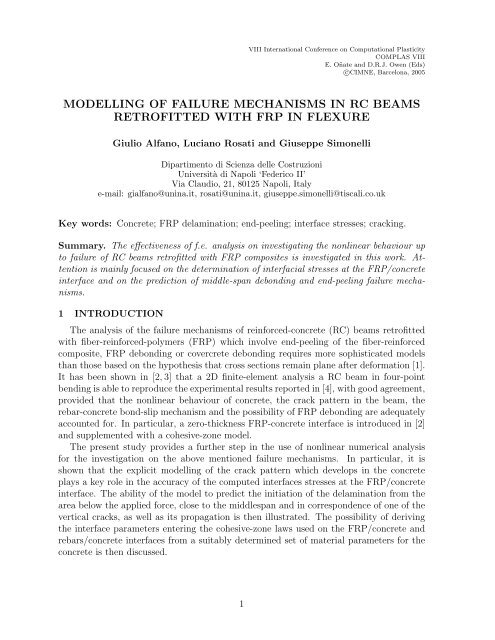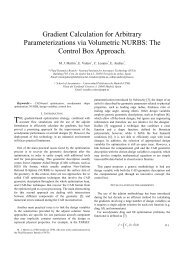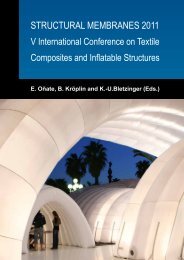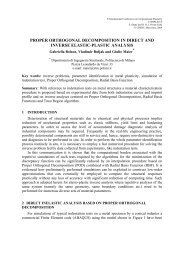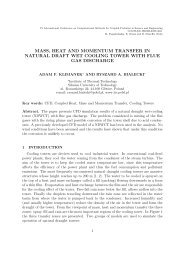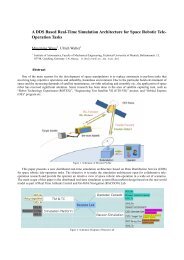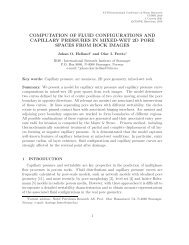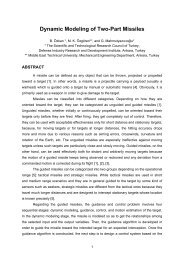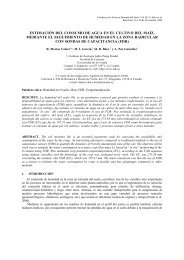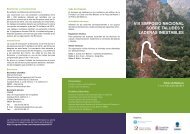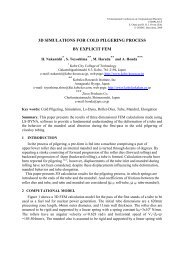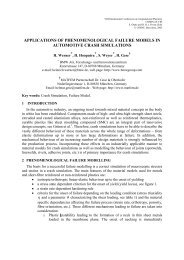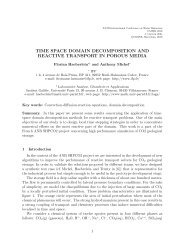modelling of failure mechanisms in rc beams retrofitted with frp
modelling of failure mechanisms in rc beams retrofitted with frp
modelling of failure mechanisms in rc beams retrofitted with frp
Create successful ePaper yourself
Turn your PDF publications into a flip-book with our unique Google optimized e-Paper software.
VIII International Conference on Computational Plasticity<br />
COMPLAS VIII<br />
E. Oñate and D.R.J. Owen (Eds)<br />
c○CIMNE, Ba<strong>rc</strong>elona, 2005<br />
MODELLING OF FAILURE MECHANISMS IN RC BEAMS<br />
RETROFITTED WITH FRP IN FLEXURE<br />
Giulio Alfano, Luciano Rosati and Giuseppe Simonelli<br />
Dipartimento di Scienza delle Costruzioni<br />
Università di Napoli ‘Federico II’<br />
Via Claudio, 21, 80125 Napoli, Italy<br />
e-mail: gialfano@un<strong>in</strong>a.it, rosati@un<strong>in</strong>a.it, giuseppe.simonelli@tiscali.co.uk<br />
Key words: Concrete; FRP delam<strong>in</strong>ation; end-peel<strong>in</strong>g; <strong>in</strong>terface stresses; crack<strong>in</strong>g.<br />
Summary. The effectiveness <strong>of</strong> f.e. analysis on <strong>in</strong>vestigat<strong>in</strong>g the nonl<strong>in</strong>ear behaviour up<br />
to <strong>failure</strong> <strong>of</strong> RC <strong>beams</strong> retr<strong>of</strong>itted <strong>with</strong> FRP composites is <strong>in</strong>vestigated <strong>in</strong> this work. Attention<br />
is ma<strong>in</strong>ly focused on the determ<strong>in</strong>ation <strong>of</strong> <strong>in</strong>terfacial stresses at the FRP/concrete<br />
<strong>in</strong>terface and on the prediction <strong>of</strong> middle-span debond<strong>in</strong>g and end-peel<strong>in</strong>g <strong>failure</strong> <strong>mechanisms</strong>.<br />
1 INTRODUCTION<br />
The analysis <strong>of</strong> the <strong>failure</strong> <strong>mechanisms</strong> <strong>of</strong> re<strong>in</strong>fo<strong>rc</strong>ed-concrete (RC) <strong>beams</strong> retr<strong>of</strong>itted<br />
<strong>with</strong> fiber-re<strong>in</strong>fo<strong>rc</strong>ed-polymers (FRP) which <strong>in</strong>volve end-peel<strong>in</strong>g <strong>of</strong> the fiber-re<strong>in</strong>fo<strong>rc</strong>ed<br />
composite, FRP debond<strong>in</strong>g or cove<strong>rc</strong>rete debond<strong>in</strong>g requires more sophisticated models<br />
than those based on the hypothesis that cross sections rema<strong>in</strong> plane after deformation [1].<br />
It has been shown <strong>in</strong> [2, 3] that a 2D f<strong>in</strong>ite-element analysis a RC beam <strong>in</strong> four-po<strong>in</strong>t<br />
bend<strong>in</strong>g is able to reproduce the experimental results reported <strong>in</strong> [4], <strong>with</strong> good agreement,<br />
provided that the nonl<strong>in</strong>ear behaviour <strong>of</strong> concrete, the crack pattern <strong>in</strong> the beam, the<br />
rebar-concrete bond-slip mechanism and the possibility <strong>of</strong> FRP debond<strong>in</strong>g are adequately<br />
accounted for. In particular, a zero-thickness FRP-concrete <strong>in</strong>terface is <strong>in</strong>troduced <strong>in</strong> [2]<br />
and supplemented <strong>with</strong> a cohesive-zone model.<br />
The present study provides a further step <strong>in</strong> the use <strong>of</strong> nonl<strong>in</strong>ear numerical analysis<br />
for the <strong>in</strong>vestigation on the above mentioned <strong>failure</strong> <strong>mechanisms</strong>. In particular, it is<br />
shown that the explicit <strong>modell<strong>in</strong>g</strong> <strong>of</strong> the crack pattern which develops <strong>in</strong> the concrete<br />
plays a key role <strong>in</strong> the accuracy <strong>of</strong> the computed <strong>in</strong>terfaces stresses at the FRP/concrete<br />
<strong>in</strong>terface. The ability <strong>of</strong> the model to predict the <strong>in</strong>itiation <strong>of</strong> the delam<strong>in</strong>ation from the<br />
area below the applied fo<strong>rc</strong>e, close to the middlespan and <strong>in</strong> correspondence <strong>of</strong> one <strong>of</strong> the<br />
vertical cracks, as well as its propagation is then illustrated. The possibility <strong>of</strong> deriv<strong>in</strong>g<br />
the <strong>in</strong>terface parameters enter<strong>in</strong>g the cohesive-zone laws used on the FRP/concrete and<br />
rebars/concrete <strong>in</strong>terfaces from a suitably determ<strong>in</strong>ed set <strong>of</strong> material parameters for the<br />
concrete is then discussed.<br />
1
Giulio Alfano, Luciano Rosati and Giuseppe Simonelli<br />
2 NONLINEAR FINITE-ELEMENT MODEL<br />
The simply supported beam <strong>in</strong> four po<strong>in</strong>t bend<strong>in</strong>g experimentally studied by White<br />
et al. <strong>in</strong> [4], see figure 2 for beam geometry, steel re<strong>in</strong>fo<strong>rc</strong>ement and load<strong>in</strong>g pattern,<br />
has been numerically analysed <strong>with</strong> the nonl<strong>in</strong>ear f<strong>in</strong>ite-element model described <strong>in</strong> [2,3].<br />
Both a control beam, <strong>with</strong> no FRP re<strong>in</strong>fo<strong>rc</strong>ement, and two types <strong>of</strong> <strong>beams</strong>, denoted <strong>with</strong><br />
SB and RB and re<strong>in</strong>fo<strong>rc</strong>ed <strong>with</strong> a pultruded CFRP lam<strong>in</strong>a and <strong>with</strong> a pre-preg CFRP<br />
sheet, respectively, have been simulated.<br />
The Menetrey-Willam elastoplastic model has been used for concrete while cohesivezone<br />
models have been adopted to simulate both the bond-slip between steel rebars and<br />
concrete and the possible debond<strong>in</strong>g <strong>of</strong> the FRP re<strong>in</strong>fo<strong>rc</strong>ement. The material properties<br />
adopted for concrete and steel rebars are those reported <strong>in</strong> the work by White et al.<br />
The paramteres which govern the bond-slip law between rebars and concrete have been<br />
chosen on the basis <strong>of</strong> similar cases reported <strong>in</strong> the literature, while for those enter<strong>in</strong>g the<br />
FRP/concrete <strong>in</strong>terface law the <strong>in</strong>dications given <strong>in</strong> codes <strong>of</strong> practice have been followed.<br />
Details on the constitutive models and the values <strong>of</strong> material properties can be found<br />
<strong>in</strong> [3].<br />
Figure 1: RC beam: geometry and load<strong>in</strong>g.<br />
In the f.e. model, which represents only half <strong>of</strong> the beam because <strong>of</strong> symmetry, a crack<br />
pattern has been predef<strong>in</strong>ed and 14 vertical cracks have been <strong>in</strong>troduced <strong>with</strong> a spac<strong>in</strong>g<br />
<strong>of</strong> 100 mm, a distance approximately the same as that observable from the experimental<br />
results reported <strong>in</strong> [4]. Contact between crack faces has been properly accounted for. The<br />
hypotheses <strong>of</strong> plane stra<strong>in</strong> and <strong>of</strong> small displacements have been made.<br />
3 Interfacial stresses between concrete and FRP<br />
The <strong>in</strong>sertion <strong>of</strong> localised cracks has a significant effect on the determ<strong>in</strong>ation <strong>of</strong> the<br />
<strong>in</strong>terfacial stresses at the FRP/concrete <strong>in</strong>terface, what is correctly captured by the nonol<strong>in</strong>ear<br />
model developed <strong>in</strong> [2, 3]. This is shown <strong>in</strong> figure 2, <strong>in</strong> which the shear stresses at<br />
the FRP/concrete <strong>in</strong>terface for a model <strong>with</strong> localised cracks and those obta<strong>in</strong>ed us<strong>in</strong>g a<br />
smeared crack approach are reported for a load level below delam<strong>in</strong>ation <strong>in</strong>itiation and<br />
2
.<br />
Giulio Alfano, Luciano Rosati and Giuseppe Simonelli<br />
for the re<strong>in</strong>fo<strong>rc</strong>ed beam RB. The smeared crack concept has been <strong>in</strong>troduced <strong>in</strong> the f<strong>in</strong>ite<br />
element model us<strong>in</strong>g Oliver’s material model, as already done <strong>in</strong> [5]. The details <strong>of</strong> the<br />
analysis done <strong>with</strong> this model are reported <strong>in</strong> [3].<br />
3<br />
2<br />
Bond stresses (N/mm^2)<br />
1<br />
0<br />
0 100 200 300 400 500 600 700 800 900 1000 1100 1200 1300 1400<br />
-1<br />
Smeared Cracks<br />
-2<br />
Localised Cracks<br />
-3<br />
Location (mm from midpo<strong>in</strong>t)<br />
Figure 2: Shear stresses at the FRP/concrete <strong>in</strong>terface for localised and smeared cracks.<br />
In the smeared crack case shear stresses at the <strong>in</strong>terface quickly tend to zero on the<br />
left-hand side <strong>of</strong> the applied fo<strong>rc</strong>e, i.e. <strong>in</strong> the constant-moment area <strong>of</strong> the beam. These<br />
stresses are smoothly distributed and their value, far from the lam<strong>in</strong>ate tips, can be well<br />
approximated us<strong>in</strong>g Jourawski’s approach. This distribution <strong>of</strong> stresses is very different<br />
from that obta<strong>in</strong>ed for a beam <strong>with</strong> localised cracks.<br />
4<br />
3<br />
Load=10 kN<br />
4<br />
3<br />
Load=88 kN<br />
shear stress (N/mm^2)<br />
2<br />
1<br />
0<br />
0 100 200 300 400 500 600 700 800 900 1000 1100 1200 1300 1400<br />
-1<br />
-2<br />
-3<br />
shear stress (N/mm^2)<br />
2<br />
1<br />
0<br />
0 100 200 300 400 500 600 700 800 900 1000 1100 1200 1300 1400<br />
-1<br />
-2<br />
-4<br />
location (mm from centerl<strong>in</strong>e)<br />
(a)<br />
-3<br />
location (mm from centerl<strong>in</strong>e)<br />
(c)<br />
shear stress (N/mm^2)<br />
4<br />
Load=87 kN<br />
3<br />
2<br />
1<br />
0<br />
0 100 200 300 400 500 600 700 800 900 1000 1100 1200 1300 1400<br />
-1<br />
Load=96 kN<br />
-2<br />
-3<br />
shear stress (N/mm^2)<br />
4<br />
3<br />
Load=82kN<br />
2<br />
1<br />
0<br />
0 100 200 300 400 500 600 700 800 900 1000 1100 1200 1300 1400<br />
-1<br />
-4<br />
location (mm from centerl<strong>in</strong>e)<br />
(b)<br />
-2<br />
location (mm from centerl<strong>in</strong>e)<br />
(d)<br />
Figure 3: Evolution <strong>of</strong> the shear stresses at the FRP/concrete <strong>in</strong>terface for the subsequent load levels:<br />
(a) P = 10 KN, (b) P = 87 KN, (c) P = 88 KN and (d) P = 82 KN.<br />
3
Giulio Alfano, Luciano Rosati and Giuseppe Simonelli<br />
The last set <strong>of</strong> results presented <strong>in</strong> figure 3 is a series <strong>of</strong> diagrams show<strong>in</strong>g the stresses<br />
at the FRP/concrete <strong>in</strong>terface <strong>in</strong> the re<strong>in</strong>fo<strong>rc</strong>ed beam RB, for several levels <strong>of</strong> the applied<br />
load. It is evident the progressive de-cohesion <strong>of</strong> the lam<strong>in</strong>ate from the concrete face,<br />
<strong>in</strong>itiat<strong>in</strong>g <strong>in</strong> the area near to the po<strong>in</strong>t <strong>of</strong> application <strong>of</strong> the load and lead<strong>in</strong>g to almost<br />
complete delam<strong>in</strong>ation and then to <strong>failure</strong>. In this case delam<strong>in</strong>ation is not triggered <strong>in</strong><br />
the vic<strong>in</strong>ity <strong>of</strong> the term<strong>in</strong>al zones <strong>of</strong> the lam<strong>in</strong>ate. Indeed the shear fo<strong>rc</strong>es at supports are<br />
limited and the stresses generated by crack open<strong>in</strong>g <strong>in</strong> the span are the critical ones.<br />
Furthermore, it is shown <strong>in</strong> [3] that the dependence <strong>of</strong> the Menetrey-Willam criterion<br />
on the Lode angle has more <strong>in</strong>fluence <strong>in</strong> the case <strong>of</strong> a re<strong>in</strong>fo<strong>rc</strong>ed beam than for the control<br />
beam. This is attributed to the fact that shear is the prevalent component <strong>of</strong> stress at the<br />
<strong>in</strong>terface and the the dependence on the Lode angle <strong>in</strong>fluences the shape <strong>of</strong> the deviatoric<br />
sections <strong>of</strong> the yield surface.<br />
In this respect it is worth observ<strong>in</strong>g that the assumed <strong>in</strong>terface model is representative<br />
<strong>of</strong> what happens <strong>in</strong> a f<strong>in</strong>ite volume <strong>in</strong>clud<strong>in</strong>g the bond<strong>in</strong>g material and a layer <strong>of</strong> concrete,<br />
whose thickness is generally estimated as 20-30 mm. Hence, as the boundary between what<br />
is concrete and what is <strong>in</strong>terface is somewhat vague, local, ref<strong>in</strong>ed analyses, account<strong>in</strong>g for<br />
a proper <strong>modell<strong>in</strong>g</strong> <strong>of</strong> this layer <strong>of</strong> damag<strong>in</strong>g concrete and for the coupl<strong>in</strong>g between damage<br />
and plasticity <strong>in</strong> the concrete, represent a consistent way for deriv<strong>in</strong>g the <strong>in</strong>put <strong>in</strong>terface<br />
parameters for the FRP/concrete cohesive-zone law start<strong>in</strong>g from material properties <strong>of</strong><br />
the concrete. Besides the compressive and tensile strengths, such properties have to<br />
<strong>in</strong>clude also values <strong>of</strong> the fracture energies obta<strong>in</strong>ed from laboratory experiments like the<br />
three-po<strong>in</strong>t-bend<strong>in</strong>g test.<br />
REFERENCES<br />
[1] O. Buyukozturk and B. Hear<strong>in</strong>g. Failure behaviour <strong>of</strong> precracked concrete <strong>beams</strong><br />
retr<strong>of</strong>itted <strong>with</strong> FRP. J. Comp. Constr. - ASCE, 2(3):138–144, 1998.<br />
[2] G. Alfano, L. Rosati, and G. Simonelli. Numerical analysis <strong>of</strong> RC <strong>beams</strong> retr<strong>of</strong>itted<br />
<strong>with</strong> FRP strips. In Proceed<strong>in</strong>gs <strong>of</strong> the International Conference ECCOMAS 2004,<br />
Jyvaskyla, F<strong>in</strong>land, 2004.<br />
[3] G. Alfano, L. Rosati, and G. Simonelli. F<strong>in</strong>ite-element <strong>modell<strong>in</strong>g</strong> <strong>of</strong> the flexural behaviour<br />
<strong>of</strong> RC <strong>beams</strong> strengthened <strong>with</strong> FRP. J. Comp. Constr. - ASCE. Submitted.<br />
[4] T.W. White, K.A. Soudki, and M. Erki. Response <strong>of</strong> RC <strong>beams</strong> strengthened <strong>with</strong><br />
CFRP lam<strong>in</strong>ates and subjected to a high rate <strong>of</strong> load<strong>in</strong>g. J. Comp. Constr. - ASCE,<br />
5(3):153–162, 2001.<br />
[5] H. Rahimi and A. Hutch<strong>in</strong>son. Concrete <strong>beams</strong> strengthened <strong>with</strong> externally bonded<br />
FRP plates. J. Comp. Constr. - ASCE, 5(1):44–56, 2001.<br />
4


